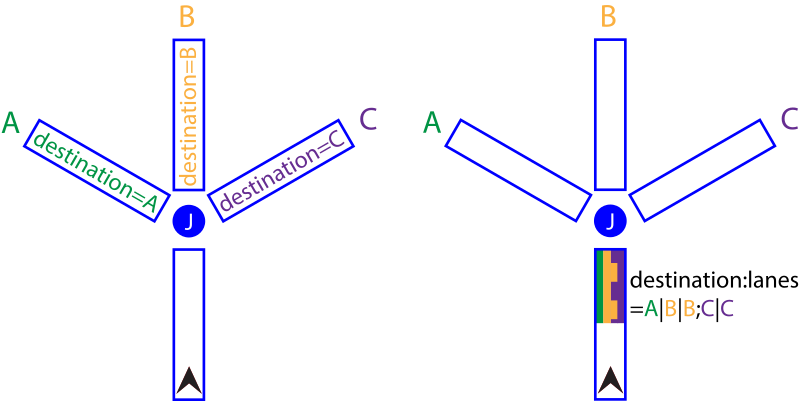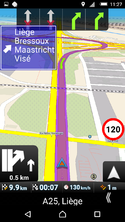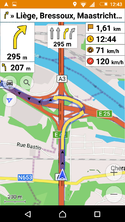Key:destination
| Description |
|---|
| Destination when following a linear feature. |
| Group: properties |
| Used on these elements |
| Useful combination |
| Status: de facto |
| Tools for this tag |
|
The key destination=* names objects that are reached, when a linear feature is being followed. The key is used in the road system as well as on waterways and guideposts.
Destination of roads
In the road system, the key destination=* describes the content of signposts or ground writing indicating the names of the locations that the tagged way is heading to. Thus navigation systems can refer to road signs that the driver actually sees.
Keys
| Key variation | Valid for | Description |
|---|---|---|
destination
|
Way | Describes the destination of the complete OSM way. Only valid in combination with oneway=yes. |
destination:forward
|
Direction | Describes the destination of all lanes of the OSM way, running in the same direction as the way itself. |
destination:backward
|
Direction | Describes the destination of all lanes of the OSM way, running in the opposite direction as the way itself. |
destination:lanes
|
Lane | Describes the destination of each lane of the OSM way. Only valid in combination with oneway=yes. |
destination:lanes:forward
|
Lane | Describes the destination of each lane of the OSM way, running in the same direction as the way itself. |
destination:lanes:backward
|
Lane | Describes the destination of each lane of the OSM way, running in the opposite direction as the way itself. |
Please note that destination=* and destination:lanes=* are two different concepts to support the announcement of signposted destinations, which can be differently evaluated by the navigation software. As they do not conflict, both approaches can co-exist on a particular road. See figure below for illustration.
Destinations per road
If the road is oneway=yes, then:
- Use the key destination=*.
If the road is bidirectional, then:
- Use destination:forward=* to describe the lanes in the direction of the OSM way.
- Use destination:backward=* to describe the lanes in the opposite direction of the OSM way.
Important note: If you reverse the direction of a bidirectional OSM way, pay attention to swap the destination:forward=* and destination:backward=* tags! JOSM shows a warning message and suggests exchanging the tags, while iD swaps the tags automatically upon reversing the way.
To enable navigation software to announce the destination at a junction, the road leaving the intersection needs to carry the respective destination=* as signposted. Multiple destinations can be tagged as semicolon-separated values.
At least the first section of a road leaving the intersection must be tagged, however the tagging can continue on further segments until some different destination is signposted. This allows navigation software to show continuously which destination a driver is following.
Destinations per lane
For details about the :lanes suffix, see
- Main article: Lanes.
Often the destinations of a road differ from lane to lane, typically in conjunction with turn:lanes. To specify those for every lane, destination:lanes=* is used on the road segment leading into the intersection. To tag them:
If the road is oneway=yes, then:
- Use the key destination:lanes=*.
- Visualize the road in the direction of the OSM way.
- Add the lane-values to the value, starting with the leftmost lane and ending with the rightmost. Separate each lane-value with a | (vertical bar).
If the road is bidirectional, then:
- Use destination:lanes:forward=* to describe the lanes in the direction of the OSM way. Visualize the road in the direction of the OSM way.
- Use destination:lanes:backward=* to describe the lanes in the opposite direction of the OSM way. Visualize the road in the opposite direction of the OSM way.
Use destination:ref:lanes=* when each lane is marked or signposted for a distinct numbered route.
Where to use?
Use destination=* together with highway=* on pieces of highway after the position of the signpost or ground writing. For details, see also the examples.
Should I use destination=* keys or a destination_sign relation?
The destination=* implementation works when all inbound ways into a junction point are signposted with the same outbound destinations for the same outbound way. This makes destination=* a popular choice among editors for: motorways and other one-way type highways; on waterway relations (waterways are by definition one-way, their direction of flow); and for simple intersections.
At intersections where the indicated destination=* depends upon the direction the driver is arriving from (could happen at two way intersections or roundabouts), this implementation cannot provide enough detail to be unambiguous for navigation, because multiple destinations apply for the same outbound way. In these cases, the destination_sign relation must be used to provide the necessary granularity.
To indicate the physical location of the signpost itself, use information=guidepost.
Danger of confusion
Do not confuse with highway=motorway_junction:
- It’s only used on motorway-exit-nodes.
- The official name of an exit is expressed with the key name=*. In some countries the same name is applied equally to every exit. If so, name=* may not correctly indicate an accurate destination.
Do not confuse with Relation:destination_sign:
- This relation is designed for any sign showing in any direction (very flexible). In principle it would be possible to use the relation for every destination sign, but it brings all drawbacks for relations with it (in opposite to a simple tag like “destination”).
Do not confuse with designation=*:
- It is the official legal classification of a road or path and has nothing to do with the information about where a way goes to. Please don’t confuse to the similar writing.
Do not confuse with direction=*.
Software that uses this feature
destination=* tagging
destination=* is used in the following navigation apps:
- Scout [1].
- Osmand [2].
- Planned usage by Skobbler Navigation [3].
- Mapfactor Navigator
- Magic Earth
- mkgmap
CheckAutopista [4] is a quality assurance tool that can show name=*, exit_to=* or destination=* tags on a selected motorway. It helps detect missing data.
The Mapbox Directions API and OSRM support the destination=* and destination:ref=* tags. The Mapbox Navigation SDK displays these tag values in the step table and turn banner and also reads aloud the tag values.
destination:lanes=* tagging
If you know navigation systems using this tagging style, please add them here
Value
The value of the destination tag should be the contents of the sign, as it would be read from beginning to end. Different destinations on the same sign are separated with semicolons. (See examples below.)
This key is only for values which are explicitly indicated on signposts or ground writings.
Whether abbreviations (as they exactly appear on a sign) should be used in a destination tag is being discussed and is disputed, on this tag's talk page. Numerically speaking, by a ratio of 20:1, the editing consensus on whether to use abbreviations that appear on signs is no, and to use the same standards as given in Exit Info and as specified in the OSM standard Names: ("Don't do it": If the name can be spelled without an abbreviation, then don't abbreviate it").
Further details
There are various tags to describe further details of destination signs:
- Proposal for sub-keys to provide additional information like reference, country, special signs/icons, more than one language
- Summary of destination keys regardless of state (in-use, proposed, ...)
Examples
Note: There is guidance and numerous United States specific examples of use of the destination tag (where it applies to exit signage), at Exit Info .
| Signpost | No. Link | Ctry | Tags | Where to tag? | Occurrence | Note |
|---|---|---|---|---|---|---|
| 430 | DE | destination=Berlin destination:ref=A 2 |
Directly at the |
Signpost at a motorway entry | Additionally it is possible to set ref=A 2 on the | |

|
448 | DE | junction:ref=26 |
At the following |
Announcement board - Signpost before motorway junctions | Additionally it is possible to set ref=26 and name=Düsseldorf-Benrath on the |

|
332 | DE | destination=Mainz;Wiesbaden | At the following |
Signpost at motorway exits | Multiple destinations for the same way are separated with a semicolon. |

|
DE | lanes=5 destination:lanes=Oberhausen;Düsseldorf;Köln-Nord|Oberhausen;Düsseldorf;Köln-Nord|Oberhausen;Düsseldorf;Köln-Nord|K-Zentrum|Olpe;Gummersbach destination:ref:lanes=A 3|A 3|A 3||A 4 |
At the |
Signpost at motorways | The destinations for each lane are separated by |. Multiple destinations for the same lane are separated with a semicolon. | |
| AT | lanes=3 destination:lanes=Brno;Poysdorf;Mistelbach|Brno;Poysdorf;Mistelbach;Graz;Wien|Graz;Wien destination:ref:lanes=A5|A5;S1|S1 |
At the |
Signpost at motorways | |||

|
CA | destination=New Maryland destination:street:lang:en=Regent Street South destination:street:lang:fr=Rue Regent Sud |
At the following |
Signpost at motorway exits | Usage of destination:street=* in two languages.
There is currently another variant of the key in use as well: destination:street:XX=*; i.e. without the 'lang:' that the basic 'destination' tag asks for. It might be advisable to use it on 'destination:street' as well to keep the namespace consistent. |
Source of some images: sicherestrassen.de
See also
- Explanation of how to determine the forward / backward direction of a way.
- The Article Lanes explains the
:lanessuffix. - The relation destination_sign may provide detailed information about the type and colour(s) of the road sign
- Proposal for sub-keys to provide additional information like reference, country, special signs/icons, more than one language
- Discussion@wiki Discussion about right to exist in Germany and situation in US
- Discussion in the mailing list talk-de[5]
- Signposts in Germany
- Lane assist - best practices for lane assistant using turn=* and destination=*
- Exit Info - best practices for specifying on and off ramp sign information
- information=guidepost - destination signs on on hiking/cycling/skiing routes
- User:Mueschel/DestinationTagging - a summary of available destination tagging schemes
- man_made=gantry - Road portal
Validators:
- Rendering of destination tags and destination_sign relations: Destination Signs
- Destination Signs - to try out tagging schemes without uploading: Destination Signs - Tagging Sandbox
- Rendering of lanes tags and some traffic and destination signs: OSM Lane Visualizer
- CheckAutopista map: checkautopista2 wiki: CheckAutopista
- Overpass-turbo: Query to find motorway links without destination=*
Destination of waterways
On a Waterway, the key destination=* is used to describe which body of water the tagged object flows into. It considers the natural flow of water, where a stream flows into a river, the river into a larger river, until eventually the last river reaches the ocean.
The key can be used either on the linear water feature (river, canal, stream) itself or, if it exists, preferably once on the waterway relation.
Examples
| 2182438 |
1756854 |





